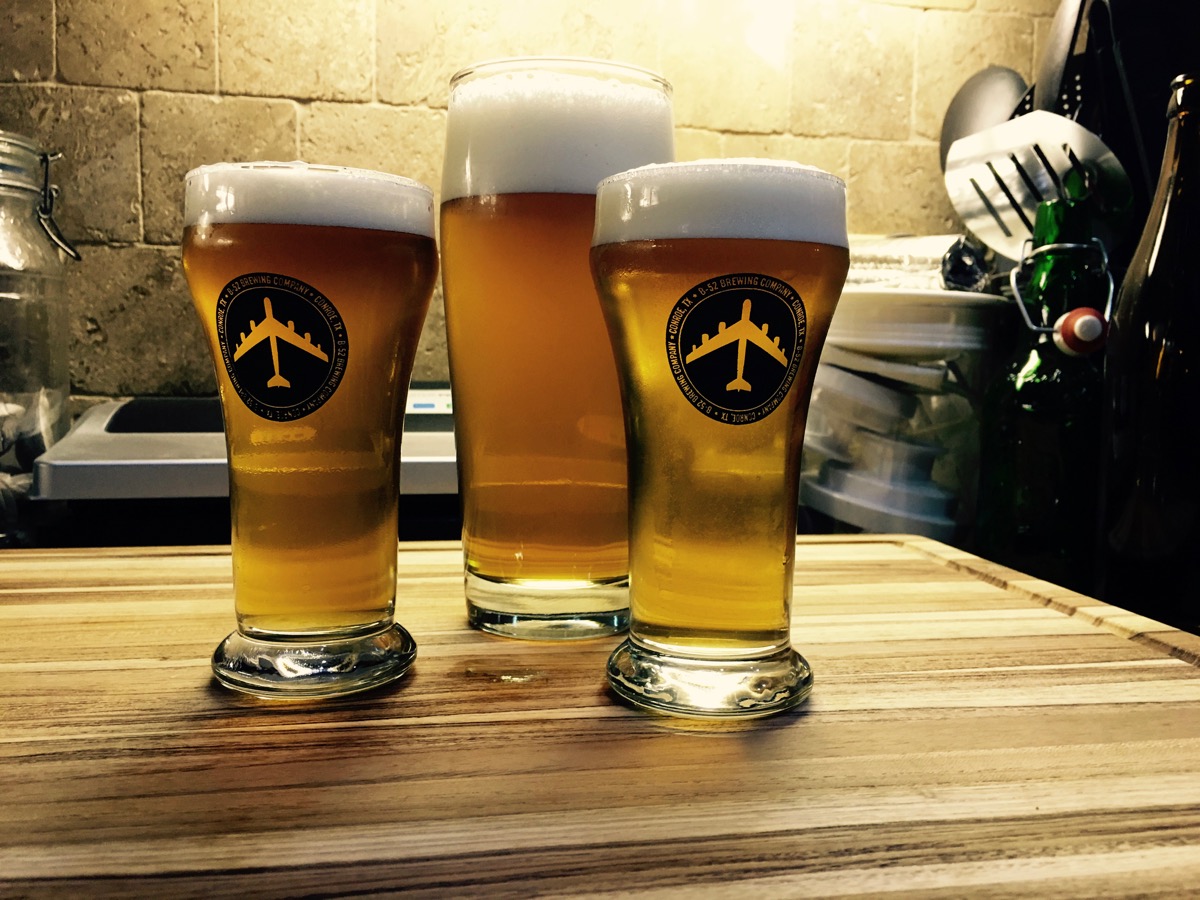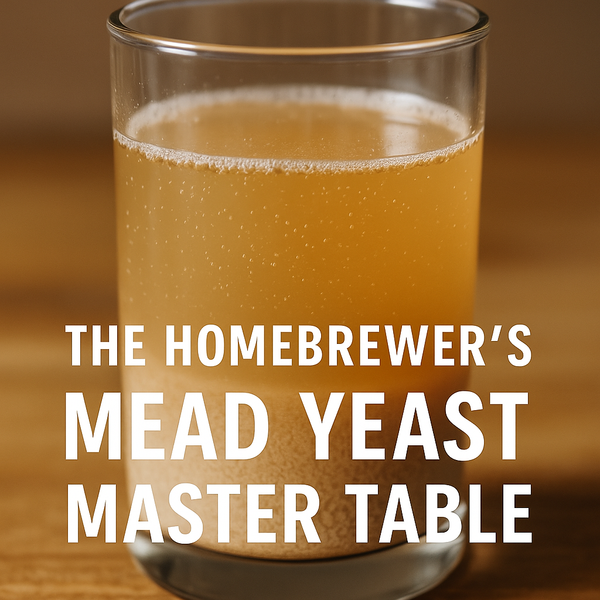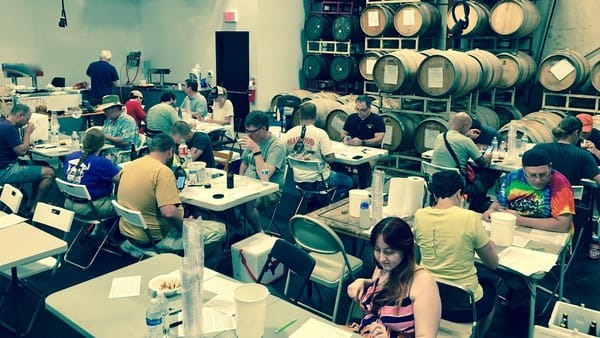Why so Bitter? A Tale of Two Lagers

It seems a non-sequitur that brewers eventually come around to appreciate and crave clean lagers. Last year, for the first time, I stuck my toe into brewing a Bohemian Pilsner. I took a keg to NHC club night with the Zealots, after confirmation from trusted friends that it was good, even with the touch of diacetyl that only a few folks picked up. I certainly didn't taste it or DMS, but did get that tiniest bit of creaminess or slickness I like in Pilsner Urquell. I am in no way claiming I nailed it, but I certainly fell in love with the style. The feedback on club night was awesome with folks seeking me out... and sharing it with new friends was inspiring.
The purpose of this article is to document my nascent journey into the world of lager brewing, and explore how small changes can create subtle and not-so-subtle differences in such a delicate beer style. Because I am a novice with these styles, I would be carefully applying anything I believe is working for me to your brewhouse.
I frequent The ABGB in Austin, which features Industry and Helle Yes. Industry is a German-styled pilsner, with a solid bitter backbone, aromatic floral hop character and dry finish, incredibly refreshing. Helle Yes is a soft delicate Munich-styled Helles, dry and crisp, yet adequately soft to show off the pilsner malt character. The result is slightly sweet, clean malt character, with a fluffy cotton candy foam to stick to your mustache. In a market filled with tongue scorching DIPAs and IPAs or uber-funky farmhouse ales, I am finding these more delicate styles fascinating. I have made friends and mentors of the brewers - their opinion is important to me and they push me to be a better brewer. They liked the BoPils, but I got some important critical feedback: Skip the specialty malt (CaraPils), except for a that tiny bit of Carafa III for color - use mashing technique rather than leaning on CaraPils for head retention. I take the feedback from GABF medal winners to heart!
I am going to get beat up about the CaraPils comment. Why use something that may add unwanted flavors when I can replace it's purpose with technique? I am willing to accept the possibility nobody would recognize CaraPils in triple-blind tests. However, the challenge was to strip down to 2 base malts + the color malt and showcase the flavor of the contenental pilsner and vienna, and exercise my step-mash capability.
I planned to rebrew my BoPils but I ran out of Saaz. Anyone that buys hops in bulk will understand the frustration on brew day when you expect to find a pound or so of fresh Saaz in the freezer, only to realize, you used it all up. My Saaz order was still waiting to be fulfilled as Nikobrew was out at the time. Fresh Saaz hops (lots of them) are key to the bitter and spicy character of a good Czech pilsner. I had already grained in and was well into the mash, called an audible and subbed in Hallertau 1:1. Now I need to admit here that I have no idea of the origin of that bag of hops - just can't remember. It may or may not have been Mittlefrue or some other variety. It was marked 2012, but kept under vacuum in the freezer and aromatic upon opening - hooray!
The water chemistry was established through the (step) mash for a very soft profile (Yellow Balanced in Bru'n Water) as well as set for mash-only minerals targeting 5.2 mash pH; the sparge only got a touch of lactic. I proceeded into the boil, Magnum FWH for bittering with a large charge of Hallertau at 10 minutes with some Whirlfloc, simple. Knocked out and chilled as quickly as possible into the freezer and conical. 4 vials of WLP830 German Lager yeast pitched at 48F/9C and let free rise to 50F/10C. Ferment out for 1 week, just a few points short of final gravity, and raised to 60F for a week for a D-rest. Comparing my notes to the BoPils (Wyeast 2124 Bohemian Lager), 830 fermented clean without any of the strong sulfur and diacetyl odors or flavors I expected. I lagered for two weeks at 32F/0C and kegged. I filtered one keg, and fined the other keg with gelatin.
I was hesitant to serve this to anyone. It had the initial softness of a BoPils, with a firm but fresh hop spicy character. The Hallertau character was strikingly different than Saaz, blending with a bit of minty flavor from the Magnum. Still, it was a quaffable drink. Not sure where to put this into style, I called it a German Lager. Everyone agreed. No DMS, no diacetyl, a bit unusual in the hop arena, but big malt character and a really lovely gold color with persistent foam. A buddy picked up some fermentation esters, not quite clean enough, and suggested taking this yeast out 3-4 generations, promising cleaner ferments. Interesting. The filtered keg was amazing once it was carbonated - and compared to the unfiltered, seemed to mature a few weeks earlier. I was excited to brew again - maybe filter an entire batch this time, thinking I can submit a lager into competition and get some BJCP feedback.
I decided to brew something more experimental to take the yeast harvest into generation two. Taking a tack more toward a classic Munich Helles (but more hoppy), I softened up my water profile slightly, again choosing to use all of the minerals in the mash, minimizing any lactic acid additions (Yellow Malty in Bru'n Water) for a 5.4 mash pH target. I also adjusted my step mash to add grain-in at 130F/54C step with a short rest, rather than my normal start at 144F/62C. "Hochkurz" in German means high and low short, and while generally applied to decoction mashing, can also describe step mashing. My RIMS system is built for step mashing, and the extra step (over my normal 3 step process) only added about 20 minutes to my brew day. The rest at 130F/54C is a short protein rest. I deployed a rest at 144F/62C for 60 minutes, another rise to 160F/71C for 30 minutes and finally a mash out. Allegedly, this provides a very fermentable wort, with dextrines to facilitate great body and foam stability. I have been using a modified Hochkurz 3-step mash for most of my lagers and saisons for a year, and love the results.
This time Hallertau was used without Magnum, a FWH addition followed by a 30 minute addition for flavor, and a substantial (for a lager) 5 minute addition, targeting half of the previous beers IBUs. The same lager schedule was used, except that I managed to accidentally start to freeze the harvested yeast while bringing the wort to temp (another lesson: small mass versus large mass in a cold environment). I slightly over pitched to compensate, and worried for 3 days before I saw signs of fermentation after discovered the temp was sitting at 40F/4.4C. 1 week later, D-Rest for a week and crash to 32F/0C for a week. The flavor was much cleaner at this point than the first generation pitch - so I fined with gelatin. 3 days later - kegged and filtered both kegs.

Filtering seems to accelerate maturation, at least in a middle gravity lager, but that is just one data point - not empirical. It strips a bit of the malt flavors and smooths out some of the sharper yeast and hop flavors right away, but the result is quite pleasant. I would say it slightly mutes the intensity of the beer. Where differences in flavor are subtle (at least in this application), the clarity differences are amazing. The photos show fined-unfiltered beer that has been lagering 6 weeks versus a week old filtered lager - making me believe filtering may be a useful tool for competition. I used a 1 mil cartridge filter for both kegs, with the second keg showing some residual chill haze suggesting I pushed the filter too far, but nothing significant. My personal preference is that lagers should be incredibly bright, reasonably dry and firmly bitter. These lagers are very similar, targeting nearly identical gravity targets, but with totally different hop schedules. Both are dry and refreshing, but the second beer has musk melon and tangelo-like aromas and flavors. The first is more minty. The beer in the middle of the picture is a blend of both beers - yielding a really good lager with a hint of mint and melon, but with big malt flavors. Maybe I can stretch a second entry by blending!
The head retention of both beers was high, lasting well past 5 minutes and even then leaving a white cap lacing through the drink. Do not be afraid to be aggressive with the carbonation, especially for bottling. I like the carb on the upside of the style parameters - in lagers, the foam carries many of the fleeting aromas: a slight wispy sulfur, sweet grain and pilsner smells and delicate noble hops. I suspect that this will help bottling to ensure proper carb for competition. The filtration appears to slightly reduce the foam stand, but both beers can easily float a bottle crown. I love to pour these quietly, then end with an aggressive pour down the center to raise the head, let this sit for a second to settle and top up to create that lovely, marshmallow fluffy texture that laces down the glass. If one has a slight lead in the foam area, it is the unfiltered beer.
The hop bills are pretty different, yet the finish beers were similar (despite the hop character). This is in no way a scientific comparison, but I believe both lagers may do well in competition, given my experience in judging. The latter (on the right as far more hop forward) perhaps in the Helles style, and the former as a German Pils.
Czech Down Audible - Bohemian Pilsner featuring Hallertau.
This was the beer that sparked my thinking. Two pilsners, different hop schedules, stripped down to show off malt quality, hop quality and technique. The result was a soft pils, firm but smooth bitterness with a hint of floral aromatics, and a low minty spice. Certainly not a Saaz-ey Czech pilsner, but a really drinkable and enjoyable beer.
[beerxml recipe=https://accidentalis.com/content/files/2025/11/puhallertau-2.xml metric=false cache=-1]
Oh Helles, I got no Saaz - German Pilsner featuring Hallertau
Ran out of my BestMälz Heidelberg pilsner malt, so supplemented with some Weyerman from SoCo Homebrew. This pilsner really features the aromatic quality of Hallertau with a fruity flavor profile that surprised me. While not as bitter, the bitterness remains firm, blending into fruity melon-like flavors. I have NEVER gotten melon from Hallertau before, so this was a nice surprise.
[beerxml recipe=https://accidentalis.com/content/files/2025/11/ohhellesigotnosaaz-2.xml metric=false cache=-1]
Exploring these styles has been a lot of fun and a test of skill and patience. I plan to continue driving this harvest of 830 out to about 6-7 generations, perhaps having something dedicated to lagering all year. Of course, I would like to try some different yeasts, but after I push this harvest as far as it can go. I suppose I should break out some premium Vienna malts and give my blogging buddies some competition!
I continue to focus on yeast harvesting utilizing one of the largest benefits of a conical. I have added Iodophor into my cleaning/sanitation regiment, using mason jars. First the jars are cleaned, then rinsed. Iodophor solution is added and let to sit (I often will store the jar with Iodophor). Then the jar is rinsed very well and StarSan is used for the final rinse, shaken well to develop foam. I will then Star San and flame the TC outlet of the conical and catch the thickest trub along with some of the slurry. I may have two jars, catching some additional liquid. I will shake this up really well, leaving the lid loose to allow venting. It is then stored in the freezer with the lagering beer.




